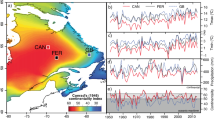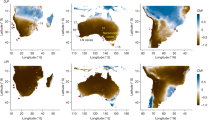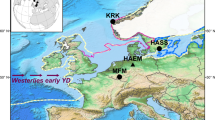Abstract
East Antarctica has shown little evidence of warming to date1,2,3 with no coherent picture of how climate change is affecting vegetation4,5,6. In stark contrast, the Antarctic Peninsula experienced some of the most rapid warming on the planet at the end of the last century2,3,7,8 causing changes to the growth and distribution of plants9,10,11. Here, we show that vegetation in the Windmill Islands, East Antarctica is changing rapidly in response to a drying climate. This drying trend is evident across the region, as demonstrated by changes in isotopic signatures measured along moss shoots12,13, moss community composition and declining health, as well as long-term observations of lake salinity14 and weather. The regional drying is possibly due to the more positive Southern Annular Mode in recent decades. The more positive Southern Annular Mode is a consequence of Antarctic ozone depletion and increased greenhouse gases, and causes strong westerly winds to circulate closer to the continent, maintaining colder temperatures in East Antarctica despite the increasing global average15,16,17,18. Colder summers in this region probably result in reduced snow melt and increased aridity. We demonstrate that rapid vegetation change is occurring in East Antarctica and that its mosses provide potentially important proxies for monitoring coastal climate change.
This is a preview of subscription content, access via your institution
Access options
Access Nature and 54 other Nature Portfolio journals
Get Nature+, our best-value online-access subscription
$29.99 / 30 days
cancel any time
Subscribe to this journal
Receive 12 print issues and online access
$209.00 per year
only $17.42 per issue
Buy this article
- Purchase on Springer Link
- Instant access to full article PDF
Prices may be subject to local taxes which are calculated during checkout





Similar content being viewed by others
Data availability
Datasets are publicly available from the Australian Antarctic Data Centre (AADC) at https://doi.org/10.4225/15/59c999a4c2145.
References
Doran, P. T. et al. Antarctic climate cooling and terrestrial ecosystem response. Nature 415, 517–520 (2002).
Convey, P. et al. Antarctic climate change and the environment. Antarct. Sci. 21, 541–563 (2009).
Turner, J. et al. Antarctic climate change and the environment: an update. Polar Rec. 50, 237–259 (2014).
Robinson, S. A., Wasley, J. & Tobin, A. K. Living on the edge—plants and global change in continental and maritime Antarctica. Glob. Change Biol. 9, 1681–1717 (2003).
Guglielmin, M., Fratte, M. D. & Cannone, N. Permafrost warming and vegetation changes in continental Antarctica. Environ. Res. Lett. 9, 045001 (2014).
Brabyn, L. et al. Quantified vegetation change over 42 years at Cape Hallett, East Antarctica. Antarct. Sci. 18, 561–572 (2006).
Turner, J. et al. Absence of 21st century warming on Antarctic Peninsula consistent with natural variability. Nature 535, 411–415 (2016).
Bromwich, D. H. et al. Central West Antarctica among the most rapidly warming regions on Earth. Nat. Geosci. 6, 139–145 (2013).
Parnikoza, I. et al. Current status of the Antarctic herb tundra formation in the central Argentine Islands. Glob. Change Biol. 15, 1685–1693 (2009).
Amesbury, M. J. et al. Widespread biological response to rapid warming on the Antarctic Peninsula. Curr. Biol. 27, 1616–1622 (2017).
Hill, P. W. et al. Vascular plant success in a warming Antarctic may be due to efficient nitrogen acquisition. Nat. Clim. Change 1, 50–53 (2011).
Clarke, L. J., Robinson, S. A., Hua, Q., Ayre, D. J. & Fink, D. Radiocarbon bomb spike reveals biological effects of Antarctic climate change. Glob. Change Biol. 18, 301–310 (2012).
Bramley-Alves, J., Wanek, W., French, K. & Robinson, S. A. Moss δ13C: an accurate proxy for past water environments in polar regions. Glob. Change Biol. 21, 2454–2464 (2015).
Hodgson, D. A. et al. Recent rapid salinity rise in three East Antarctic lakes. J. Paleolimnol. 36, 385–406 (2006).
Marshall, G. J. Trends in the Southern Annular Mode from observations and reanalyses. J. Clim. 16, 4134–4143 (2003).
Robinson, S. A. & Erickson, D. J. Not just about sunburn—the ozone hole’s profound effect on climate has significant implications for Southern Hemisphere ecosystems. Glob. Change Biol. 21, 515–527 (2015).
Marshall, G. J. & Thompson, D. W. J. The signatures of large-scale patterns of atmospheric variability in Antarctic surface temperatures. J. Geophys. Res. Atmos. 121, 3276–3289 (2016).
Abram, N. J. et al. Evolution of the Southern Annular Mode during the past millennium. Nat. Clim. Change 4, 564–569 (2014).
Pecl, G. T. et al. Biodiversity redistribution under climate change: impacts on ecosystems and human well-being. Science 355, eaai9214 (2017).
Convey, P. et al. The spatial structure of Antarctic biodiversity. Ecol. Monogr. 84, 203–244 (2014).
Wasley, J., Robinson, S. A., Lovelock, C. E. & Popp, M. Some like it wet—biological characteristics underpinning tolerance of extreme water stress events in Antarctic bryophytes. Funct. Plant Biol. 33, 443–455 (2006).
Lee, J. R. et al. Climate change drives expansion of Antarctic ice-free habitat. Nature 547, 49–54 (2017).
Lenné, T., Bryant, G., Hocart, C. H., Huang, C. X. & Ball, M. C. Freeze avoidance: a dehydrating moss gathers no ice. Plant Cell Environ. 33, 1731–1741 (2010).
Wasley, J. et al. Bryophyte species composition over moisture gradients in the Windmill Islands, East Antarctica: development of a baseline for monitoring climate change impacts. Biodiversity 13, 257–264 (2012).
Melick, D. & Seppelt, R. Vegetation patterns in relation to climatic and endogenous changes in Wilkes Land, continental Antarctica. J. Ecol. 85, 43–56 (1997).
Malenovský, Z., Turnbull, J. D., Lucieer, A. & Robinson, S. A. Antarctic moss stress assessment based on chlorophyll content and leaf density retrieved from imaging spectroscopy data. New Phytol. 208, 608–624 (2015).
Williamson, C. E. et al. Solar ultraviolet radiation in a changing climate. Nat. Clim. Change 4, 434–441 (2014).
Assessment for Decision-Makers: Scientific Assessment of Ozone Depletion: 2014 Report No. 56 (World Meteorological Organization, 2014).
Villalba, R. et al. Unusual Southern Hemisphere tree growth patterns induced by changes in the Southern Annular Mode. Nat. Geosci. 5, 793–798 (2012).
Weimerskirch, H., Louzao, M., De Grissac, S. & Delord, K. Changes in wind pattern alter albatross distribution and life-history traits. Science 335, 211–214 (2012).
Gooseff, M. N. et al. Decadal ecosystem response to an anomalous melt season in a polar desert in Antarctica. Nat. Ecol. Evol. 1, 1334–1338 (2017).
Dunn, J. L. & Robinson, S. A. Ultraviolet B screening potential is higher in two cosmopolitan moss species than in a co-occurring Antarctic endemic moss: implications of continuing ozone depletion. Glob. Change Biol. 12, 2282–2296 (2006).
Lovelock, C. E. & Robinson, S. A. Surface reflectance properties of Antarctic moss and their relationship to plant species, pigment composition and photosynthetic function. Plant Cell Environ. 25, 1239–1250 (2002).
Robinson, S. A., Wasley, J. & King, D. Indicator 72—Windmill Islands Terrestrial Vegetation Dynamics (Australian Antarctic Data Centre, 2009); https://go.nature.com/2xm08l7
Australia State of the Environment 2011: Independent Report to the Australian Government Minister for Sustainability, Environment, Water, Population and Communities 477–565 (State of the Environment 2011 Committee, 2011).
Lewis Smith, R. I. Plant community dynamics in Wilkes Land, Antarctica. Proc. NIPR Symp. Polar Biol. 3, 229–244 (1990).
Emslie, S. D. & Woehler, E. J. A 9000-year record of Adélie penguin occupation and diet in the Windmill Islands, East Antarctica. Antarct. Sci. 17, 57–66 (2005).
Robinson, S. A., Wasley, J., Popp, M. & Lovelock, C. E. Desiccation tolerance of three moss species from continental Antarctica. Funct. Plant Biol. 27, 379–388 (2000).
Waterman, M. J. The What and Where of Ultraviolet Protective Mechanisms in Antarctic Mosses. PhD thesis, Univ. Wollongong (2015).
Ashcroft, M. B. et al. Moving beyond presence and absence when examining changes in species distributions. Glob. Change Biol. 23, 2929–2940 (2017).
Selkirk, P. M. & Seppelt, R. D. Species distribution within a moss bed in Greater Antarctica. Symp. Biol. Hungarica 35, 279–284 (1987).
Post, A. Photoprotective pigment as an adaptive strategy in the Antarctic moss Ceratodon purpureus. Polar Biol. 10, 241–245 (1990).
Waterman, M. J. et al. Antarctic moss biflavonoids show high antioxidant and ultraviolet-screening activity. J. Nat. Prod. 80, 2224–2231 (2017).
Drǎguţ, L., Tiede, D. & Levick, S. R. ESP: a tool to estimate scale parameter for multiresolution image segmentation of remotely sensed data. Int. J. Geogr. Inf. Sci. 24, 859–871 (2010).
Royles, J. et al. Plants and soil microbes respond to recent warming on the Antarctic Peninsula. Curr. Biol. 23, 1702–1706 (2013).
Hua, Q. Radiocarbon: a chronological tool for the recent past. Quat. Geochronol. 4, 378–390 (2009).
Rubino, M. et al. A revised 1000 year atmospheric δ13C-CO2 record from Law Dome and South Pole, Antarctica. J. Geophys. Res. Atmos. 118, 8482–8499 (2013).
Dan, Y. The paper trail of the 13C of atmospheric CO2 since the industrial revolution period. Environ. Res. Lett. 6, 034007 (2011).
Bronk Ramsey, C. Bayesian analysis of radiocarbon dates. Radiocarbon 51, 337–360 (2009).
Hogg, A. G. et al. SHCal13 Southern Hemisphere calibration, 0–50,000 years cal BP. Radiocarbon 55, 1889–1903 (2013).
Hua, Q., Barbetti, M. & Rakowski, A. Z. Atmospheric radiocarbon for the period 1950–2010. Radiocarbon 55, 2059–2072 (2013).
Williams, T. & Flanagan, L. Effect of changes in water content on photosynthesis, transpiration and discrimination against 13CO2 and C18O16O in Pleurozium and Sphagnum. Oecologia 108, 38–46 (1996).
Rice, S. Variation in carbon isotope discrimination within and among Sphagnum species in a temperate wetland. Oecologia 123, 1–8 (2000).
Rice, S. K. & Giles, L. The influence of water content and leaf anatomy on carbon isotope discrimination and photosynthesis in Sphagnum. Plant Cell Environ. 19, 118–124 (1996).
Farquhar, G., Ehleringer, J. & Hubick, K. Carbon isotope discrimination and photosynthesis. Annu. Rev. Plant. Physiol. Plant. Mol. Biol. 40, 503–537 (1989).
Ducré-Robitaille, J.-F., Vincent, L. A. & Boulet, G. Comparison of techniques for detection of discontinuities in temperature series. Int. J. Climatol. 23, 1087–1101 (2003).
Ruggieri, E. A Bayesian approach to detecting change points in climatic records. Int. J. Climatol. 33, 520–528 (2013).
Acknowledgements
The authors wish to thank D. Bergstrom, Z. Malenovský, A. Nydahl, J. Dunn, A. Lucieer and other Australian National Antarctic Research Expedition expeditioners for assistance in the field, A. Netherwood for production of Fig. 1, and B. Raymond and A. Constable for providing feedback on the manuscript. Funding was provided by the Australian Research Council (DP110101714 and DP180100113), Antarctic Science Grants 1313, 3129, 3042 and 4046, and Australian Institute of Nuclear Science and Engineering grants 05142P and 06155. We acknowledge financial support from the Australian Government for the Centre for Accelerator Science at ANSTO through the National Collaborative Research Infrastructure Strategy and the University of Wollongong’s Global Challenges Program as part of the Sustaining Coastal and Marine Zones challenge. J.W., L.J.C., J.B.-A., M.J.W. and D.H.K. were supported by Australian Postgraduate Awards/Research Training Program scholarships. M.J.W. also received an Australian Institute of Nuclear Science and Engineering postgraduate award (grant ALNSTU2110).
Author information
Authors and Affiliations
Contributions
S.A.R., D.H.K., J.B.-A., M.J.W., J.W., J.D.T., E.R.-C. and L.J.C. conceived the experiments. J.B.-A., J.W., J.D.T., S.A.R., R.E.M., E.R.-C. and L.J.C. performed the fieldwork. D.H.K. performed the image analysis. D.H.K., J.B.-A., J.W., J.D.T., T.B. and K.M. processed the moss microsamples. L.J.C., S.A.R., J.B.-A. and M.J.W. identified samples to species level. M.J.W., J.B.-A., L.J.C., L.A.B. and Q.H. performed the dating and isotope analysis. M.B.A., D.H.K., M.J.W., J.B.-A. and Q.H. analysed the data. S.A.R., M.B.A., M.J.W., D.H.K., J.B.-A., J.W., J.D.T., R.E.M. and Q.H. co-wrote the manuscript.
Corresponding author
Ethics declarations
Competing interests
The authors declare no competing interests
Additional information
Publisher’s note: Springer Nature remains neutral with regard to jurisdictional claims in published maps and institutional affiliations.
Supplementary information
Supplementary Information
Supplementary tables S1–S2, Supplementary figures 1–3, Supplementary references
Fig2_Model.txt
R2OpenBUGS Bayesian model used by the R script (Fig2_script.txt) to estimate the change in relative abundance of three moss species and moribund (dead or dying) moss over time
Fig2_script.txt
The relative abundance of each species in each quadrat and each year was modelled in R using the R2OpenBUGS Bayesian modelling package (see Fig2_Model.txt) and this R script (Fig2_script.txt)
Rights and permissions
About this article
Cite this article
Robinson, S.A., King, D.H., Bramley-Alves, J. et al. Rapid change in East Antarctic terrestrial vegetation in response to regional drying. Nature Clim Change 8, 879–884 (2018). https://doi.org/10.1038/s41558-018-0280-0
Received:
Accepted:
Published:
Issue Date:
DOI: https://doi.org/10.1038/s41558-018-0280-0
This article is cited by
-
Mapping scientific fieldwork data: a potential tool for improving and strengthening Antarctic Specially Protected Areas as an effective measure for protecting Antarctic biodiversity
Biodiversity and Conservation (2024)
-
Interactive effects of changes in UV radiation and climate on terrestrial ecosystems, biogeochemical cycles, and feedbacks to the climate system
Photochemical & Photobiological Sciences (2023)
-
Basking in the sun: how mosses photosynthesise and survive in Antarctica
Photosynthesis Research (2023)
-
Moss bank composition on Galindez Island (Argentine Islands, maritime Antarctic)
Polar Biology (2023)
-
Atmospheric chemosynthesis is phylogenetically and geographically widespread and contributes significantly to carbon fixation throughout cold deserts
The ISME Journal (2022)



